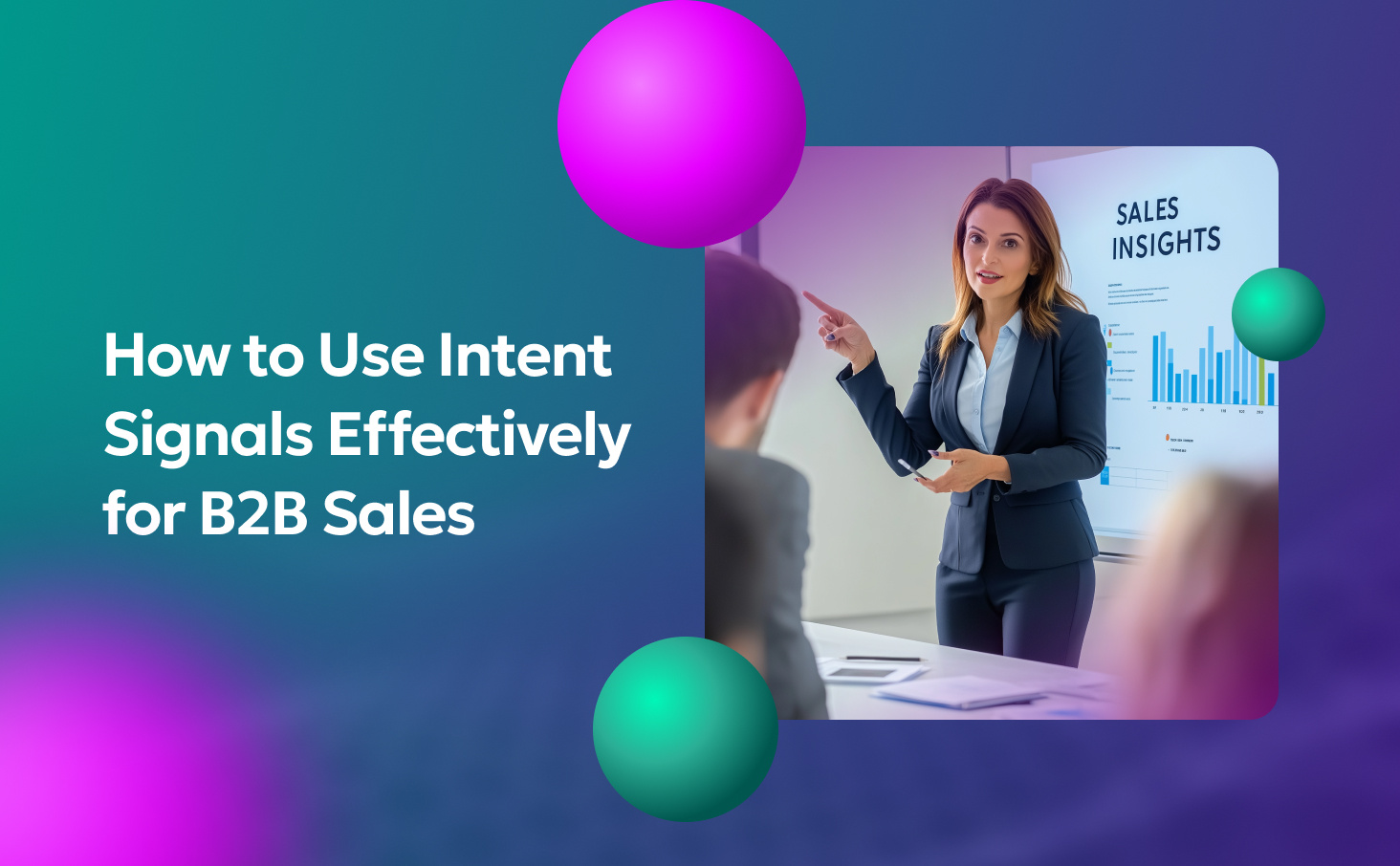

Mia Tayam
~2 min
How to Use Intent Signals Effectively for B2B Sales
Many businesses don’t fully understand how to analyze and interpret buyer intent data. According to research, 20% admitted that they still had more to learn about buyer intent data and that they knew very little about it and had much more to learn.
But once you know how to tap into these insights, it can help you with new opportunities and focus on prospects who are genuinely interested. Proper utilization of buyer intent signals have led to larger transaction sizes (43%), more concluded deals (38%), and better conversion rates (47%).
These signals, gathered from digital behavior and contextual data, provide a clear picture of a prospect’s interest or readiness to engage or buy. When you capture and act on these signals at the right time, your team can engage with prospects in a way that feels perfectly timed and relevant, offering them exactly what they need and when they need it.
Types of Intent Signals
Intent data comes from the actions prospects take before making a purchase. These actions can be as obvious as a hand raise by filling out a form to request a demo, or very subtle, like repeatedly visiting a pricing page. Both types of signals are valuable, but they require different approaches to capture and interpret.
Hand Raise Signals
These signals happen when a prospect explicitly reveals their interest by providing contact information or engaging with content that indicates a strong interest in your product or content. Examples include:
- Requesting a demo from sales
- Filling out a contact form
- Signing up for a product trial
- Downloading a whitepaper (indicates interest in your content, but not necessarily readiness to buy)
- Attending a webinar (indicates interest in your content, but not necessarily readiness to buy)
These signals are straightforward and often tracked in CRM or marketing automation tools. They represent clear intent and typically trigger immediate follow-up from sales teams.
Source: Slack Alerts

Source: HubSpot
Subtle Signals
These signals, on the other hand, are actions that do not require the prospect to reveal their identity but still indicate interest. These might include:
- Browsing product pages or case studies on your website
- Opening your emails and clicking on links leading to your content
- Exploring product implementation documentation
- Engaging with social media content related to your industry
- Researching solutions online and reading reviews of your product or competitors

Continuous content consumption from the same target account.
Source: N.Rich

Checking the company page on LinkedIn.
Source: LinkedIn Sales Navigator
These signals are typically tracked with analytics or tools like N.Rich that can capture both 1st party and 3rd party intent data and can be just as valuable as hand raise signals, particularly when observed in combination.
How Buyer Intent Signals Are Used
Understanding and leveraging buyer intent signals can significantly improve your sales strategy by allowing you to focus on prospects most likely to convert. Here are key areas in B2B sales where intent signals can be particularly useful:
1. Lead Scoring and Prioritization
Intent signals enable you to easily prioritize leads, ensuring that your efforts are focused on the most promising prospects. By creating your Target Account List (TAL) based on intent levels, you can make your sales process more efficient.
2. Personalized Outreach
Intent signals provide insights into what your leads are interested in. For example, if a prospect is exploring specific product features, you can tailor your communication to highlight how your solution has benefited similar companies. This makes your outreach more relevant and create better engagement.
3. Timing Your Follow-Ups
Knowing when to follow up is as important as knowing whom to follow up with. Intent signals offer insights into the optimal timing for your follow-up efforts, ensuring that you reach out when the prospect is most likely to be receptive.
4. Account-Based Marketing (ABM)
If you are doing ABM strategy, intent signals help you tailor campaigns to address specific needs at each stage of the buyer's journey. This ensures that no aspect of the buyer’s journey is overlooked, enabling you to guide prospects down the sales funnel more effectively.
5. Sales Forecasting and Pipeline Management
Intent signals can also enhance your sales forecasting and pipeline management by identifying which deals are more likely to close. Strong intent signals—such as engaging with sales content or requesting a demo—indicate that these deals may close soon, allowing you to manage your pipeline with greater accuracy.
Here is a workflow, one of our clients, Forecom, showing how they successfully implement a signal-based selling strategy.
The process begins with detecting a signal from a website visitor. You can use tools like N.Rich, which can deanonymize website visitors. You can then check if the account exists in your CRM. But if the account is new, you have to see if this matches your ICP. This helps determine the next action: if the account does not fit the ICP, no further action is taken. However, if it matches your ICP description, an alert is sent via Slack, or an automated email is triggered for real-time engagement.

Source: Forecom
How To Act on Intent Signals: 5 Actionable Plays
Understanding and using intent signals effectively is key in B2B sales. These signals tell you how interested a potential customer is and help you decide how to approach them. Here’s a straightforward way to categorize and act on these signals in your daily sales routine:
1. Behavioral Intent Signals
These signals are based on what prospects do on your website or digital platforms—like which pages they visit or if they download any content.
- Example: A prospect regularly visits your pricing page or downloads your product brochures.
- Play: These prospects are likely very interested. Reach out with specific offers or follow up with a demo that aligns with what they’ve been exploring.
2. Firmographic Intent Signals
These signals relate to the company the prospect works for, like their industry or recent growth.
- Example: You notice a company is hiring a lot or just got new funding.
- Play: Customize your pitch to show how your product can help them grow or manage their new resources effectively.
3. Technographic Intent Signals
These signals are about the technology a company is using or looking into.
- Example: A prospect is researching tools that work well with your product or is switching to new software.
- Play: Highlight how your product integrates with what they’re already using or how it can make their transition smoother or how your offerings differ from their current software. It is best to use battle cards in these cases.
4. Engagement-Based Intent Signals
These signals come from how prospects interact with your content or communications.
- Example: A prospect frequently opens your emails or clicks on your product links.
- Play: They’re clearly interested, so follow up with more details or offer to set up a meeting to discuss how you can help them.
5. Contextual Intent Signals
These signals come from broader factors like industry trends or strict compliance in regulations that might affect your prospect.
- Example: A company is expanding its market in Europe therefore they need to make sure that their vendors are GDPR compliant.
- Play: Reach out to discuss how your service can help them stay compliant and be able to take advantage of new opportunities.
Case Study: Utilizing Buyer Intent Signals
One successful example of buyer intent signals is when we utilized N.Rich for N.Rich— our work with AutoStore, now a valued client.
Early 2023, we identified AutoStore’s increasing intent through their digital activity, specifically as they explored competitor platforms like 6sense and Terminus, and installed a competitor’s tag on their website at some point. This behavior indicated they were actively searching for solutions, giving us the perfect opportunity to reach out when they were most open to considering new vendors.
Using our platform's intent data capabilities, it signaled our team to immediately secure a call with them to present the value of our platform and highlight how we were able to identify their intent using our platform which will be very helpful in their planned market expansion.
Knowing they were initially considering our competitors, we were able to tailor our approach to emphasize the advantages we offer and how our solution aligned with their goals. Without delay, we offered POC, giving them the opportunity to make an apples-to-apples comparison.
After almost 4 months of collaboration, where we guided them in optimizing their GTM efforts, AutoStore made the decision to partner with us.
Since then, they’ve not only renewed their contract but have become one of our most loyal and satisfied partners.
Read full story here




